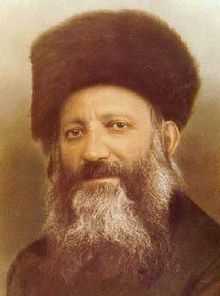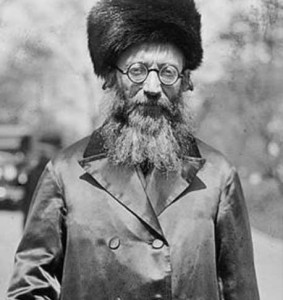 Abraham Isaac Hakohen Kook (5625/1865-5695/1935), served as the first Ashkenazic chief rabbi of Erets Israel. He was born in Grieva, a suburb of Dvinsk, Latvia, to Rabbi Shlomo Zalman Hakohen Kook and Perel Zlata Felman. The elder Kook’s intellectual roots were in the famed Volozhin Yeshiva, founded by the eminent disciple of the Vilna Gaon, Rabbi Hayyim of Volozhin. Abraham Isaac’s maternal grandfather Raphael, on the other hand, was a hasid of Rabbi Menahem Mendel Schneersohn of Lubavitch, author of Responsa Tsemah Tsedek. At an early age, Abraham Isaac imbibed both of these influences, which would later germinate in his thought, producing a unique fusion of the mitnagdic and hasidic traditions. Abraham Isaac studied in his youth with the rabbi of neighboring Dvinsk, Rabbi Reuven Halevi, author of Responsa Degel haRe’uveni. Later, he studied in Lutchin and Smorgon. The young genius was engaged to the daughter of one of the great rabbis of the generation, Rabbi Elijah David Rabinowitz-Te’omim of Ponevezh.
Abraham Isaac Hakohen Kook (5625/1865-5695/1935), served as the first Ashkenazic chief rabbi of Erets Israel. He was born in Grieva, a suburb of Dvinsk, Latvia, to Rabbi Shlomo Zalman Hakohen Kook and Perel Zlata Felman. The elder Kook’s intellectual roots were in the famed Volozhin Yeshiva, founded by the eminent disciple of the Vilna Gaon, Rabbi Hayyim of Volozhin. Abraham Isaac’s maternal grandfather Raphael, on the other hand, was a hasid of Rabbi Menahem Mendel Schneersohn of Lubavitch, author of Responsa Tsemah Tsedek. At an early age, Abraham Isaac imbibed both of these influences, which would later germinate in his thought, producing a unique fusion of the mitnagdic and hasidic traditions. Abraham Isaac studied in his youth with the rabbi of neighboring Dvinsk, Rabbi Reuven Halevi, author of Responsa Degel haRe’uveni. Later, he studied in Lutchin and Smorgon. The young genius was engaged to the daughter of one of the great rabbis of the generation, Rabbi Elijah David Rabinowitz-Te’omim of Ponevezh.
During the year preceding his marriage, Abraham Isaac studied in Volozhin, where he developed an intimate relationship with the rosh yeshivah or dean, Rabbi Naphtali Zevi Judah Berlin.
After serving as rabbi in the small town of Zoimel and later in the city of Boisk (Bauska), Latvia, in 1904 Rabbi Kook accepted the invitation of the port city of Jaffa, Erets Israel, to serve as its rabbi. In Erets Israel, Rabbi Kook, who was himself an interesting mixture of the old and the new, exerted a profound influence on both the Old and New Yishuv, as they were referred to in those days. His brilliance in all aspects of Torah attracted the finest minds among Jerusalem’s young pietists: Zevi Pesah Frank, Jacob Moses Harlap, Israel Porath, and others, who would become the leaders of the next generation. By the same token, Rav Kook had a unique gift for reaching out to the modern elements in Erets-Israeli society who were alienated from Jewish tradition. Thus, Rav Kook cemented relations with the halutsim, the pioneers in the outlying settlements. Especially in the new settlement of Rehovot was Rav Kook able to count many friends. His deep philosophical thoughts, as well as the poetic expression he gave to them, could not fail to impress the avant-garde writers of the day. Samuel Joseph Agnon, Joseph Brenner, et al supped at Rav Kook’s shalosh se’udot (third meal of the Sabbath). Rav Kook served as rabbi of Jaffa for a decade.
In 1914 Rav Kook traveled to Europe to attend the conference of Agudat Israel, a newly formed Orthodox movement, in order to impress upon the delegates the importance of Orthodox participation in the settlement of Erets Israel. Due to the outbreak of World War One the conference was cancelled, and Rav Kook found himself stranded on the European continent, unable to sail home. He spent the war years, first as a private citizen in St. Gallen, Switzerland in the home of an admirer Mr. Abraham Kimhi, and later in London as rabbi of the prestigious East End synagogue Mahzikei Hadat, founded by East European immigrants.
 At war’s end Rav Kook returned to Erets Israel, becoming the Ashkenazic Rabbi of Jerusalem, and eventually Chief Rabbi of Erets Israel. It was during this final phase of his career that Rav Kook emerged as a world leader of Jewry. In 1924 he spent the better part of a year in the United States as part of a three-man rabbinic delegation sent to raise funds for the destitute yeshivot of Eastern Europe. About that time, Rav Kook established a yeshivah of his own in Jerusalem, known ever since as Merkaz Harav. The institutions Rav Kook established, namely the chief rabbinate and Yeshivat Merkaz Harav, continue to this day. Rav Kook’s teaching was preserved both orally by his disciples, and in the abundant writings he penned, some of which have yet to see the light of print. Rav Kook returned his soul to his Maker on 3 Ellul, 5695/1935, the exact day on which he had entered Jerusalem sixteen years earlier.
At war’s end Rav Kook returned to Erets Israel, becoming the Ashkenazic Rabbi of Jerusalem, and eventually Chief Rabbi of Erets Israel. It was during this final phase of his career that Rav Kook emerged as a world leader of Jewry. In 1924 he spent the better part of a year in the United States as part of a three-man rabbinic delegation sent to raise funds for the destitute yeshivot of Eastern Europe. About that time, Rav Kook established a yeshivah of his own in Jerusalem, known ever since as Merkaz Harav. The institutions Rav Kook established, namely the chief rabbinate and Yeshivat Merkaz Harav, continue to this day. Rav Kook’s teaching was preserved both orally by his disciples, and in the abundant writings he penned, some of which have yet to see the light of print. Rav Kook returned his soul to his Maker on 3 Ellul, 5695/1935, the exact day on which he had entered Jerusalem sixteen years earlier.

